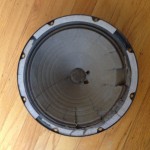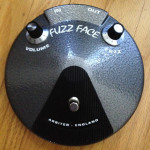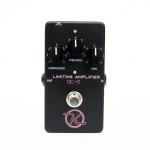Two months ago we posted part 1 of our project Jensen speaker rebuild for our  original 1964 pre-CBS Fender Super Reverb. The amp has original transformers and used to sound wonderful – but the original Jensen speakers were in rough shape. The cones had tears, and the magnets on two of the speakers had shifted off-center, causing the voice coils to freeze and no longer produce any sound.
original 1964 pre-CBS Fender Super Reverb. The amp has original transformers and used to sound wonderful – but the original Jensen speakers were in rough shape. The cones had tears, and the magnets on two of the speakers had shifted off-center, causing the voice coils to freeze and no longer produce any sound.
Read More »
Wading Through the Sea of Opinions
I recently sold an amplifier and stirred up a fun conversation with the buyer when we met in person. He was still lamenting about his amplifier choice, as he spent considerable research time – as many of us do these days – and sought out guidance online.
The problem, he discovered as he waded through countless forums, websites and video reviews, was that the opinions he found varied greatly. How could an amp be described as unreliable, shrill in tone, or lifeless and sterile in feel, while at the same time also being defined as being bullet-proof, a “holy grail” amp, and smooth with perfect overdrive bite?
Read More »
Vintage Jensen Speaker Rebuild Project Part 1
At LegendaryTones.com, when we’ve taken on amplifier upgrade projects in the past,  often we have recommended replacing stock factory speakers in the process with new models. This is especially true with Fender reissue amplifiers, as often the reissue models include speakers that do not sound or respond anything like the originals – regardless of the brand name they are badged with.
often we have recommended replacing stock factory speakers in the process with new models. This is especially true with Fender reissue amplifiers, as often the reissue models include speakers that do not sound or respond anything like the originals – regardless of the brand name they are badged with.
Read More »
Reverb Pedal Buying Guide for Various Applications
Deciding which effects pedals are right for you can get pretty tough. There are a lot of great options out there, and, let’s face it, it’s hard not to feel like you want them all. Unfortunately, our rockstar aspirations rarely jive with our less-than-rockstar budgets. So we’re forced to choose between various pedals. If you are currently trying to decide on the right reverb pedal for your board, we’ve got some advice to help out. Today we’ll be looking at a few fantastic reverb pedals and discussing which applications each of them is best suited for.
Read More »
Sonus Pedals Fuzz Face 1966 Replica Reviewed
It has been some time since we wrote our Fuzz Feast series about both vintage and  recent fuzz options on the market. After seeing the prices of original fuzz units climb, I wondered what the boutique market now had available in 2015 as far as the most accurate of Fuzz Face clones. During my search, I stumbled across Sonus Pedals based in the Netherlands and its Fuzz Face 1966 replica.
recent fuzz options on the market. After seeing the prices of original fuzz units climb, I wondered what the boutique market now had available in 2015 as far as the most accurate of Fuzz Face clones. During my search, I stumbled across Sonus Pedals based in the Netherlands and its Fuzz Face 1966 replica.
Read More »
Keeley Electronics GC-2 Limiting Amplifier Review
Among musicians, Robert Keeley has become a virtual household name in quality  compression for well over a decade. With humble beginnings building early units based on the famed grey Ross compressor from out of his home, to now having sold over 40,000 compressors and growing his business with a complete lineup of original designs, Robert Keeley and the team at Keeley Electronics have achieved great success since the early days.
compression for well over a decade. With humble beginnings building early units based on the famed grey Ross compressor from out of his home, to now having sold over 40,000 compressors and growing his business with a complete lineup of original designs, Robert Keeley and the team at Keeley Electronics have achieved great success since the early days.
The latest designs in the company’s compression family are original and based on new circuits that Robert and his engineering team spent years perfecting. Today we’ll look review the more compact model, the Keeley GC-2 Limiting Amplifier.
Legendary Artist Profile: David Gilmour
David Gilmour holds a special place in the heart of many guitarists, let alone among the fans of Pink Floyd’s music. By sheer virtue of his expressive playing and songwriting, he should be mentioned in the same breath as Clapton, Page, Townshend or Beck. While he may not be the technical virtuoso, he has clearly defined his own sound and style, one that is unique and beautiful. From his early forays into psychedelia to his solo albums, numerous guest appearances and the entire Pink Floyd canon, his ability to bring his own voice to the music stands as a remarkable achievement. With the recent release of a live solo DVD and continuing interest in the Floyd catalog, the Gilmour phenomenon continues to delight guitarists and music fans alike.
 Far from being a complete dissertation of Gilmour’s sound and style, this article strives to paint a broad picture of the tolls used and offer some insight into the David Gilmour phenomenon. As noted by The Wall producer/collaborator Bob Ezrin, “…with Gilmour, equipment is secondary to touch. You can give him a ukulele and he’ll make it sound like a Stradivarius. He’s truly got the best set of hands with which I have ever worked.”
Far from being a complete dissertation of Gilmour’s sound and style, this article strives to paint a broad picture of the tolls used and offer some insight into the David Gilmour phenomenon. As noted by The Wall producer/collaborator Bob Ezrin, “…with Gilmour, equipment is secondary to touch. You can give him a ukulele and he’ll make it sound like a Stradivarius. He’s truly got the best set of hands with which I have ever worked.”
Read More »
Marshall Super Lead Tone Tips and Tricks
The following Marshall Super Lead tone tips and tricks will enable you to get much more versatility out of this legendary amplifier. Some of these may even surprise you. One thing to note – NONE of these involve modification to the original Marshall circuit. Those looking for the true Marshall sound only need use an original, unmodified Super Lead.
Read More »
Fuzz Feast Part 2 – An Assortment of Today’s Fuzzes
In part one, we spent some time with some vintage fuzz classics. Now let’s move forward in time and take a look at some Fuzzes that are currently on the market (with the exception of one which we’ll get to).
Fuzz, more than any other effect, really comes down to personal preferences. As a result, there is no judgment here with regards to what is the “better” fuzz unit – Just sonic descriptions and details that can help you make some choices depending on the direction that you’d like to go with your fuzz tones.
Fuzz Feast Part 1 – An Examination of Vintage Fuzz Boxes
I have a confession. As a guitarist for well over 25 years, I had always been an “anti-fuzz” person. In fact, I can honestly say I hated and despised the sound of fuzzes that I had heard. I couldn’t understand the point of purposefully making a guitar sound as atrocious and “lo-fi” as possible in mind. A fuzz tone after all, sounded nothing like an electric guitar should.
During this period of time, my search for the epitome of rock tone had to do with capturing rock guitar tones from the likes of players like Angus Young of AC/DC and of course Edward Van Halen. In my mind, any tone that deviated from those was simply bad tone, or at best, “sub-par.”
Read More »